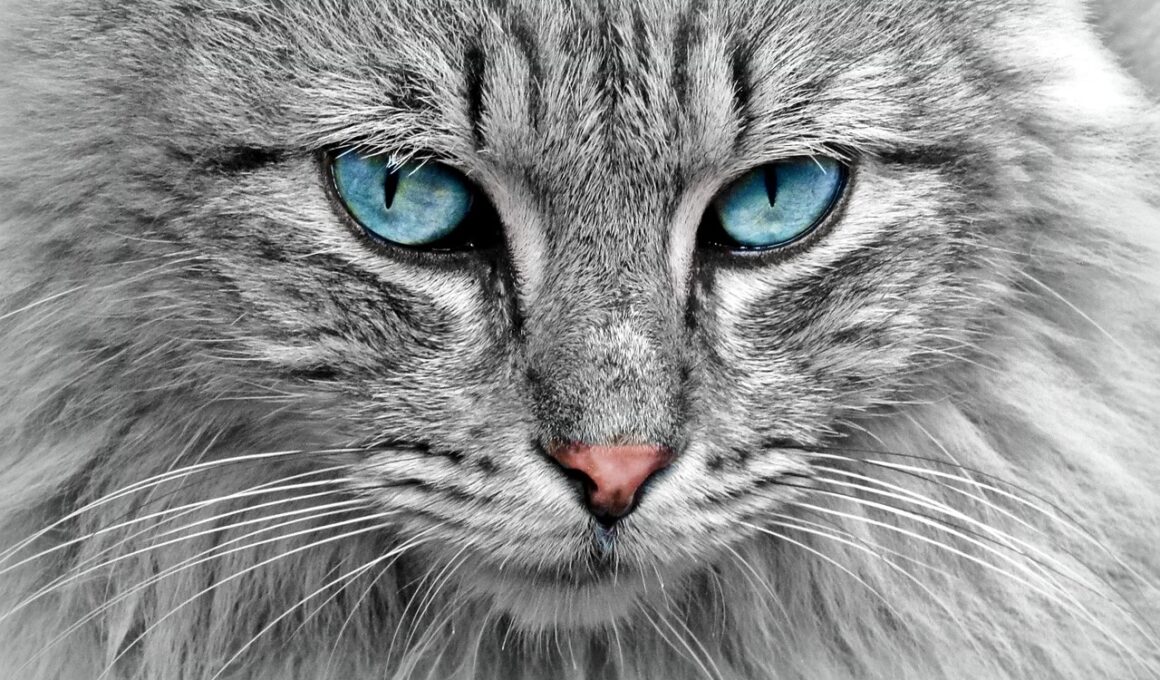The Role of Early Socialization in Preventing Cat Aggression
Understanding cat behavior is crucial for any owner, especially regarding aggression. Early socialization significantly influences how a cat interacts with its environment and other animals. Socialization encompasses exposure to different experiences, sounds, and people during a cat’s early life. Cats that receive positive interactions during their critical development stages are less likely to exhibit aggressive behaviors later. This period typically spans from two to nine weeks of age, and during this time, kittens are highly receptive to learning about the world. Providing a variety of experiences can foster confidence, reducing anxiety-driven aggression. For instance, allowing kittens to meet various people can help them acclimatize to social situations, therefore preventing fear-based responses. Workshops and classes, such as kitten kindergarten, can be beneficial, offering guided interaction with peers. A well-socialized cat will adapt better to new environments, leading to a healthier emotional life. Owners should actively seek opportunities for their feline friends to engage with different stimuli positively. Understanding the importance of early socialization can lead to a more harmonious relationship with their pets and minimize instances of fear or aggression in adulthood.
The impact of genetics on a cat’s behavior is also noteworthy. Certain breeds are predisposed to specific personality traits affecting aggression levels. For instance, more dominant breeds may exhibit behaviors like territorial aggression. While genetic predispositions play a role, socialization remains vital in shaping behavior. Kittens from breeds known for being skittish or anxious can benefit immensely from positive experiences. By introducing them to various stimuli, owners can help mitigate these aggressive tendencies. For example, gradually exposing them to children, other pets, or even household noises can help desensitize them. This proactive approach reduces the likelihood of aggressive behavior manifesting later in life. It’s essential for owners to remain patient during this process. Overwhelming a kitten with too much stimulation too quickly can backfire, leading to reinforced anxiety and aggression. Instead, a gradual introduction allows them to process their experiences positively. Offering a safe space, such as a designated retreat area, empowers them to choose comfort versus confrontation. Understanding these nuances ensures owners take the right steps to manage and improve their pet’s behavior effectively, leading to a happier feline companion.
Understanding Fear-Based Aggression
Fear-based aggression is one of the most common problems in cats, often stemming from inadequate socialization during early life stages. When a cat feels threatened or anxious, it may resort to aggressive behaviors as a defense mechanism. This natural response can be further exacerbated if the animal was not exposed positively to various environments or situations as a kitten. Consequently, poorly socialized cats may react aggressively when faced with unfamiliar stimuli, leading to frustrating situations for owners. Recognizing signs of fear, such as hissing, swatting,or hiding, is crucial in addressing this issue. It’s essential to understand that aggression is not an innate trait in cats but rather a product of their environment and experiences. To alleviate fear-based aggression, cat owners should focus on creating a calm and predictable environment. Gradual exposure to fear-inducing situations can help desensitize the cat, building confidence and reducing anxiety. Techniques such as using calming pheromones or providing a safe retreat area can significantly improve a cat’s behavior. Implementing these strategies fosters security, encourages exploration, and ultimately helps prevent any potential future aggression issues.
Another effective strategy for reducing fear-based aggression is positive reinforcement training. Utilizing rewards helps shape desired behaviors in animals by associating good experiences with various stimuli. For example, when a cat approaches a potentially frightening object or situation, offering treats and praise reinforces that behavior. This association gradually teaches the cat that they are safe and that the previously intimidating experience does not pose a threat. Additionally, gradual desensitization techniques ensure the cat can comfortably navigate the environment without fear. Owners can create a controlled setting where the cat gradually interacts with the object of its fear under safe conditions. This method relies heavily on the owner’s patience and consistent practice. It’s critical to monitor the cat’s body language and reactions throughout the process, making adjustments as necessary. Including distraction techniques, such as toys or engaging activities, can further help redirect their focus away from anxiety-inducing elements. Understanding that every cat is unique leads to tailored approaches, ensuring successful outcomes. Positive reinforcement training not only benefits socialization but strengthens the bond between the cat and its owner.
The Importance of Environment
Creating a stimulating environment is crucial for a well-socialized cat. A lack of stimulation can lead to behavioral issues, including aggression. Cats are natural explorers, and providing them with various enrichment opportunities lowers boredom and anxiety. An enriched environment includes interactive toys, scratching posts, and climbing structures, which cater to their natural instincts. Additionally, engaging with the cat through playtime fosters social bonds and trust, enhancing overall well-being. Ensuring the living space is cat-friendly can deter territorial aggression by making the cat feel secure in its domain. For instance, placing resources like food, water, and litter boxes in accessible, safe locations can minimize competition and stress, especially in multi-pet households. Moreover, incorporating hiding spots or vertical spaces, such as shelves or cat trees, helps provide retreat options when the cat feels overwhelmed. Throughout this process, observation remains vital; monitoring the cat’s reactions to new stimuli allows for informed adjustments to the environment. Always prioritize a cat’s comfort, making gradual changes that promote exploration while reducing tension. A stimulating environment not only supports socialization but also promotes healthy behaviors and reduces aggression symptoms.
Moreover, the role of early experiences in aggression cannot be understated. The first few months of a cat’s life are critical; positive experiences during this time lay the foundation for a well-adjusted adult cat. This includes interactions with humans and other animals, exposure to various environments, and routine handling. Cats subjected to negative experiences, such as rough handling or inadequate socialization, are more likely to develop anxiety and aggressive tendencies later in life. It is essential to prioritize positive reinforcement and gentle handling during these formative months. Engaging with a kitten through interactions like gentle petting, grooming, and play helps build trust. These practices encourage the kitten to associate humans with pleasant experiences rather than fear or distress. Ensuring the kitten has safe and regular interactions with well-mannered adult cats can also provide invaluable social learning moments. Experiences during this pivotal period shape behavioral patterns, influencing how a cat responds to various situations throughout life. Thus, learning the importance of positive early experiences is key in preventing future aggression and promoting a healthy, happy cat life.
Final Thoughts on Socialization
In summary, the significance of early socialization in preventing cat aggression cannot be overlooked. Kittens exposed to various positive experiences during their critical development phase tend to grow into well-adjusted adult cats with minimal behavioral issues. Conversely, inadequate socialization can lead to fear and anxiety, resulting in aggressive tendencies. Responsible cat ownership includes recognizing the crucial window for socialization and actively seeking opportunities for kittens to engage with the world. Techniques such as gradual exposure to different experiences, positive reinforcement training, and providing a stimulating environment profoundly impact developing a cat’s social skills. Additionally, understanding a cat’s individual needs furthers this goal, allowing for tailored approaches that respect their unique personalities. Owners play a vital role in ensuring their pets experience a positive upbringing where exploration is encouraged, and aggression risks are minimized. Ultimately, investing time and effort in proper kitten socialization yields long-term benefits, culminating in a well-adjusted companion that enriches the owner’s life. Prioritizing social interactions enables pet owners to form strong, fulfilling relationships with their furry friends while minimizing behavioral problems in adulthood.
Preventing cat aggression through socialization is an essential component of responsible pet ownership. Documenting experiences and observing behavior patterns can enhance understanding of individual cats’ needs. By implementing socialization strategies early, owners can contribute to their cat’s happiness and overall health. Regular vet visits for health checks and vaccinations are important, ensuring the kitten’s overall well-being, which in turn supports positive social interactions. Well-cared-for cats are more likely to engage positively with their environments and fellow cats. Owners should also educate themselves on recognizing signs of stress or aggression and remembering the impact of their actions. Maintaining a patient and calm demeanor is essential during socialization sessions, as cats often mirror their owner’s emotional state. By setting realistic expectations, owners can navigate the socialization process without feeling overwhelmed. Creating a supportive, engaging environment empowers kittens to explore confidently while minimizing anxiety triggers. Ultimately, prevention of aggression is symbiotic, requiring active engagement from owners. By fostering social skills early on, pet owners can nurture positive behavior patterns, paving the way for a lifetime of companionship filled with love and trust.


